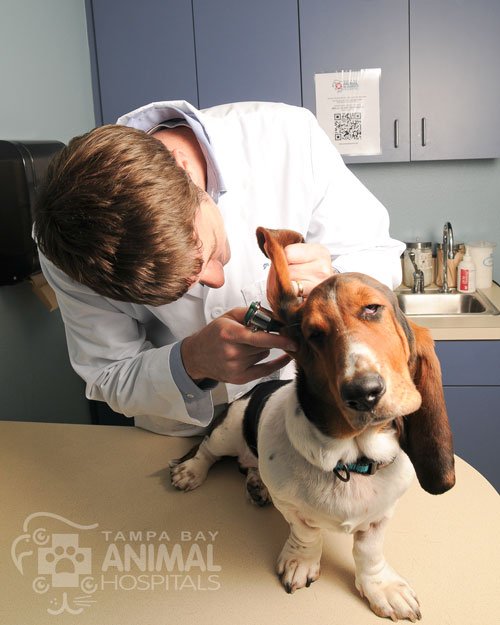Time to clean your pet’s ears?

Tampa Veterinarians see a lot of patients with ear infections. In fact, it’s the second most common reason for a client visit, according to pet health insurer, VPI Pet Insurance. With ear problems prompting so many trips to the vet, should ear cleaning be a necessary part of grooming your pet?
Generally, cleaning a dog’s ears on a routine basis is not necessary. That’s because animals have a naturally occurring self-cleansing process. However, that doesn’t mean pet owners should never take notice of their dog’s ears. Certain breeds, lifestyles and physical characteristics will make a dog more prone to “abnormal situations,” in which the pet’s normal homeostasis is disrupted. This is when something, either systemically or locally in the ear, interferes with the normal surface barrier defense system and the normal cleaning process that keeps bacteria and yeast under control.
There are signs to watch for if your pet is having an issue with its ears. These may include:
- Shaking its head
- Flapping its ears
- Rubbing at its ears, either with a paw or by rubbing against furniture or carpet
- Self-massaging the ear to ease itch, pain or irritation
- Debris and/or redness inside the ear
- Sores inside the ear
- Odor in the ear due to abnormal oils and bacteria
If you [the pet owner] look in the ear, you can see sometimes a lot of debris, which may ge a sign of an infection or problem. You may see redness on the ear flaps (inside) or sores developing. And then there’s also odor that occurs when you have an abnormal ear.
Breeds to watch
There are certain breeds of dogs—such as Shar Peis, bulldogs and poodles—that have narrow ear canals and have a higher chance of incurring ear issues. Poodles, especially, have more hair in the canals. The hair itself is not a problem, but if they’ve got something abnormal with their whole defense system, all that extra hair in there makes it difficult.
Cocker spaniels are notorious for ear problems.
Top 10 breeds prone to ear infections
Veterinary Pet Insurance Co. (VPI) policyholders spent more than $58 million in 2012 treating the 10 most common medical conditions affecting their pets. Ear infections were the No. 2 condition that prompted a visit to the veterinarian.
Here are the top 10 breeds that VPI received ear infection claims from in 2012.
- Shar Pei
- Cocker spaniel (all types)
- Bloodhound
- Clumber spaniel
- English springer spaniel
- Soft-coated wheaten terrier
- Bulldog (all types)
- Pug
- Newfoundland
- Golden retriever
When to clean your pet’s ears
It’s best to consult your veterinarian before going forward with an ear-cleaning regimen. Unlike cleaning the teeth, cleaning the ears does not need be done regularly. If a pet owner suspects that something may be wrong with the ear, it’s advised to visit the veterinarian and establish whether the dog’s ear needs to be cleaned by the owner either routinely or for an instructed period of time.
 Cleaning the dog’s ears without first seeing a veterinarian is not a good idea, because you don’t know what’s going on inside. You don’t know if there has been a ruptured ear drum; you don’t know if there’s a stick or a stone or something stuck down inside the ear that needs to be fished out by a veterinarian. A veterinarian can diagnose the problem and make the proper recommendations, which may be cleaning and/or medication.
Cleaning the dog’s ears without first seeing a veterinarian is not a good idea, because you don’t know what’s going on inside. You don’t know if there has been a ruptured ear drum; you don’t know if there’s a stick or a stone or something stuck down inside the ear that needs to be fished out by a veterinarian. A veterinarian can diagnose the problem and make the proper recommendations, which may be cleaning and/or medication.
Typically, there are two situations for which a dog’s ears would need to be cleaned regularly. The first is when a veterinarian instructs for it to be done, and the second is when the dog is frequently in water. Water in their ears disrupts the normal defense barrier system in that ear, and can make them prone to getting infections and irritation and inflammation.
If there needs to be ear cleaning
A veterinarian should show the owner how to properly clean the dog’s ears because there are a lot of different techniques, and it depends on what the problem is.
There are a couple of precautions to always remember: First, never use a Q-tip, because it tends to push the wax and debris further into the ear. Second, be sure a groomer does not pluck the hair out of the dog’s ears, unless that hair is contributing to an ear problem; doing so may cause irritation.
One thing pet owners should also consider is that if the dog has an ear infection, it could be very painful for them. Forcing the dog to get its ears cleaned or putting medication in them can be a dangerous situation for the owner and the dog.
If your pet doesn’t want you to do it, don’t, because it hurts. You’re just going to create a problem, and you need to look to alternatives.
(courtesy of healthypet.com, Leonard Jonas, DVM)- Behavior (15)
- Caring for your pet (292)
- cat (16)
- Community Events (20)
- dog (17)
- From Our Clients (15)
- Happy Tails (12)
- News (454)
- Press (53)
- Products (2)
- Questions (4)
- Recalls (1)
- Special Offers (6)
- Tips & Advice (231)
- Uncategorized (21)
- Veterinary Services (49)
